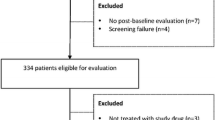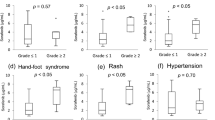Abstract
Background and Objectives
Sorafenib has various adverse events that can cause treatment discontinuation or dose reduction. The aim of this study was to compare the safety profile between renal cell carcinoma (RCC) and hepatocellular carcinoma (HCC) patients receiving sorafenib under real-life practice conditions. Furthermore, we investigated the relationship between sorafenib exposure and clinical outcomes.
Methods
A total of 91 Japanese cancer patients (RCC, n = 21; HCC, n = 70) treated with sorafenib were enrolled. Toxicity was graded according to the National Cancer Institute Common Toxicity Criteria for Adverse Events (NCI-CTCAE) version 4.0. Single blood samples were collected at each clinic visit and serum sorafenib concentrations were measured by liquid chromatography–tandem mass spectrometry (LC–MS/MS). The incidence of adverse events was analyzed according to cancer type and sorafenib concentration.
Results
Hand-foot skin reaction (HFSR) was the most common adverse event among RCC (76 %) and HCC (66 %) patients. Elevations in hepatic transaminases and pancreatic amylase developed more frequently in patients with RCC than in those with HCC (p < 0.05), while hyperbilirubinemia and thrombocytopenia were observed more often in HCC patients than in RCC patients (p < 0.05). Pharmacokinetic data were available from 52 patients (RCC, n = 16; HCC, n = 36). HCC patients showed significantly higher dose-normalized concentrations than RCC patients (p = 0.0184). Sorafenib concentrations were significantly greater in patients with grade ≥2 HFSR and hypertension than in those not experiencing the adverse events (p = 0.0045 and 0.0453, respectively). Furthermore, receiver operating characteristic curves revealed optimal cutoff concentrations of sorafenib to predict grade ≥2 HFSR (5.78 μg/mL) and hypertension (4.78 μg/mL). In addition, a trend of prolonged overall survival was observed in HCC patients who achieved a maximal sorafenib concentration of ≥4.78 μg/mL during treatment compared with those who did not achieve the threshold concentration (12.0 vs. 6.5 months; log-rank p = 0.0824).
Conclusions
The results of this study suggest that the safety and pharmacokinetic profiles of sorafenib differ between Japanese cancer patients with RCC and HCC. Furthermore, the serum sorafenib concentration could be used as a guide to avoiding the development of severe HFSR while allowing prediction of the incidence of grade ≥2 hypertension in patients with RCC and HCC, and may potentially be related to the clinical efficacy of sorafenib for HCC.







Similar content being viewed by others
References
Wilhelm SM, Carter C, Tang L, et al. BAY 43-9006 exhibits broad spectrum oral antitumor activity and targets the RAF/MEK/ERK pathway and receptor tyrosine kinases involved in tumor progression and angiogenesis. Cancer Res. 2004;64:7099–109.
Escudier B, Eisen T, Stadler WM, et al. Sorafenib for treatment of renal cell carcinoma: final efficacy and safety results of the phase III treatment approaches in renal cancer global evaluation trial. J Clin Oncol. 2009;27:3312–8.
Llovet JM, Ricci S, Mazzaferro V, et al. Sorafenib in advanced hepatocellular carcinoma. N Engl J Med. 2008;359:378–90.
Cheng AL, Kang YK, Chen Z, et al. Efficacy and safety of sorafenib in patients in the Asia-Pacific region with advanced hepatocellular carcinoma: a phase III randomised, double-blind, placebo-controlled trial. Lancet Oncol. 2009;10:25–34.
Szmit S, Zaborowska M, Waśko-Grabowska A, et al. Cardiovascular comorbidities for prediction of progression-free survival in patients with metastatic renal cell carcinoma treated with sorafenib. Kidney Blood Press Res. 2012;35:468–76.
Estfan B, Byrne M, Kim R. Sorafenib in advanced hepatocellular carcinoma: hypertension as a potential surrogate marker for efficacy. Am J Clin Oncol. 2013;36:319–24.
Kim DH, Son IP, Lee JW, et al. Sorafenib (Nexavar®, BAY 43-9006)-induced hand-foot skin reaction with facial erythema. Ann Dermatol. 2011;23:119–22.
Lathia C, Lettieri J, Cihon F, et al. Lack of effect of ketoconazole-mediated CYP3A inhibition on sorafenib clinical pharmacokinetics. Cancer Chemother Pharmacol. 2006;57:685–92.
Di Gion P, Kanefendt F, Lindauer A, et al. Clinical pharmacokinetics of tyrosine kinase inhibitors: focus on pyrimidines, pyridines and pyrroles. Clin Pharmacokinet. 2011;50:551–603.
Zimmerman EI, Roberts JL, Li L, et al. Ontogeny and sorafenib metabolism. Clin Cancer Res. 2012;18:5788–95.
Peer CJ, Sissung TM, Kim A, et al. Sorafenib is an inhibitor of UGT1A1 but is metabolized by UGT1A9: implications of genetic variants on pharmacokinetics and hyperbilirubinemia. Clin Cancer Res. 2012;18:2099–107.
Minami H, Kawada K, Ebi H, et al. Phase I and pharmacokinetic study of sorafenib, an oral multikinase inhibitor, in Japanese patients with advanced refractory solid tumors. Cancer Sci. 2008;99:1492–8.
Houk BE, Bello CL, Poland B, et al. Relationship between exposure to sunitinib and efficacy and tolerability endpoints in patients with cancer: results of a pharmacokinetic/pharmacodynamic meta-analysis. Cancer Chemother Pharmacol. 2010;66:357–71.
Jain L, Woo S, Gardner ER, et al. Population pharmacokinetic analysis of sorafenib in patients with solid tumours. Br J Clin Pharmacol. 2011;72:294–305.
Boudou-Rouquette P, Narjoz C, Golmard JL, et al. Early sorafenib-induced toxicity is associated with drug exposure and UGTIA9 genetic polymorphism in patients with solid tumors: a preliminary study. PLoS One. 2012;7:e42875.
Hu S, Chen Z, Franke R, et al. Interaction of the multikinase inhibitors sorafenib and sunitinib with solute carriers and ATP-binding cassette transporters. Clin Cancer Res. 2009;15:6062–9.
Gnoth MJ, Sandmann S, Engel K, et al. In vitro to in vivo comparison of the substrate characteristics of sorafenib tosylate toward P-glycoprotein. Drug Metab Dispos. 2010;38:1341–6.
Hornecker M, Blanchet B, Billemont B, et al. Saturable absorption of sorafenib in patients with solid tumors: a population model. Invest New Drugs. 2012;30:1991–2000.
Antoun S, Baracos VE, Birdsell L, et al. Low body mass index and sarcopenia associated with dose-limiting toxicity of sorafenib in patients with renal cell carcinoma. Ann Oncol. 2010;21:1594–8.
Mir O, Coriat R, Blanchet B, et al. Sarcopenia predicts early dose-limiting toxicities and pharmacokinetics of sorafenib in patients with hepatocellular carcinoma. PLoS One. 2012;7:e37563.
Tod M, Mir O, Bancelin N, et al. Functional and clinical evidence of the influence of sorafenib binding to albumin on sorafenib disposition in adult cancer patients. Pharm Res. 2011;28:3199–207.
Strumberg D, Richly H, Hilger RA, et al. Phase I clinical and pharmacokinetic study of the novel Raf kinase and vascular endothelial growth factor receptor inhibitor BAY 43-9006 in patients with advanced refractory solid tumors. J Clin Oncol. 2005;23:965–72.
Pécuchet N, Lebbe C, Mir O, et al. Sorafenib in advanced melanoma: a critical role for pharmacokinetics? Br J Cancer. 2012;107:455–61.
Marks AB, Gerard R, Fournier P, et al. Sorafenib-induced hepatic encephalopathy. Ann Pharmacother. 2009;43:2121.
Schramm C, Schuch G, Lohse AW. Sorafenib-induced liver failure. Am J Gastroenterol. 2008;103:2162–3.
Lencioni R, Kudo M, Ye SL, et al. First interim analysis of the GIDEON (Global Investigation of therapeutic DEcisions in hepatocellular carcinoma and Of its treatment with sorafeNib) non-interventional study. Int J Clin Pract. 2012;66:675–83.
Mizuno T, Fukudo M, Terada T, et al. Impact of genetic variation in breast cancer resistance protein (BCRP/ABCG2) on sunitinib pharmacokinetics. Drug Metab Pharmacokinet. 2012;27:631–9.
Adinolfi LE, Giordano MG, Andreana A, et al. Hepatic fibrosis plays a central role in the pathogenesis of thrombocytopenia in patients with chronic viral hepatitis. Br J Haematol. 2001;113:590–5.
Morimoto M, Numata K, Kondo M, et al. Higher discontinuation and lower survival rates are likely in elderly Japanese patients with advanced hepatocellular carcinoma receiving sorafenib. Hepatol Res. 2011;41:296–302.
Arrondeau J, Mir O, Boudou-Rouquette P, et al. Sorafenib exposure decreases over time in patients with hepatocellular carcinoma. Invest New Drugs. 2012;30:2046–9.
Li J, Zhao M, He P, et al. Differential metabolism of gefitinib and erlotinib by human cytochrome P450 enzymes. Clin Cancer Res. 2007;13:3731–7.
Dong PP, Fang ZZ, Zhang YY, et al. Substrate-dependent modulation of the catalytic activity of CYP3A by erlotinib. Acta Pharmacol Sin. 2011;32:399–407.
Fukudo M, Ikemi Y, Togashi Y, et al. Population pharmacokinetics/pharmacodynamics of erlotinib and pharmacogenomic analysis of plasma and cerebrospinal fluid drug concentrations in Japanese patients with non-small cell lung cancer. Clin Pharmacokinet. 2013;52:593–609.
Swift B, Nebot N, Lee JK, et al. Sorafenib hepatobiliary disposition: mechanisms of hepatic uptake and disposition of generated metabolites. Drug Metab Dispos. 2013;41:1179–86.
Zimmerman EI, Hu S, Roberts JL, et al. Contribution of OATP1B1 and OATP1B3 to the disposition of sorafenib and sorafenib-glucuronide. Clin Cancer Res. 2013;19:1458–66.
Herraez E, Lozano E, Macias RI, et al. Expression of SLC22A1 variants may affect the response of hepatocellular carcinoma and cholangiocarcinoma to sorafenib. Hepatology. 2013;58:1065–73.
Miller AA, Murry DJ, Owzar K, et al. Phase I and pharmacokinetic study of sorafenib in patients with hepatic or renal dysfunction: CALGB 60301. J Clin Oncol. 2009;27:1800–5.
Dranitsaris G, Vincent MD, Yu J, et al. Development and validation of a prediction index for hand-foot skin reaction in cancer patients receiving sorafenib. Ann Oncol. 2012;23:2103–8.
Jain L, Sissung TM, Danesi R, et al. Hypertension and hand-foot skin reactions related to VEGFR2 genotype and improved clinical outcome following bevacizumab and sorafenib. J Exp Clin Cancer Res. 2010;29:95.
Acknowledgments
This work was supported in part by a Grant-in-Aid for Scientific Research from the Ministry of Education, Culture, Sports, Science, and Technology of Japan, by a Grant-in-Aid from the Fujiwara Memorial Foundation, by a Grant-in-Aid from the Nakatomi Foundation, and by a Grant-in-Aid from The Research Foundation for Pharmaceutical Sciences. M. Fukudo, T. Ito, T. Mizuno, K. Shinsako, E. Hatano, S. Uemoto, T. Kamba, T. Yamasaki, O. Ogawa, H. Seno, T. Chiba, and K. Matsubara have no conflicts of interest that are directly relevant to the content of this study.
Author information
Authors and Affiliations
Corresponding author
Rights and permissions
About this article
Cite this article
Fukudo, M., Ito, T., Mizuno, T. et al. Exposure–Toxicity Relationship of Sorafenib in Japanese Patients with Renal Cell Carcinoma and Hepatocellular Carcinoma. Clin Pharmacokinet 53, 185–196 (2014). https://doi.org/10.1007/s40262-013-0108-z
Published:
Issue Date:
DOI: https://doi.org/10.1007/s40262-013-0108-z




